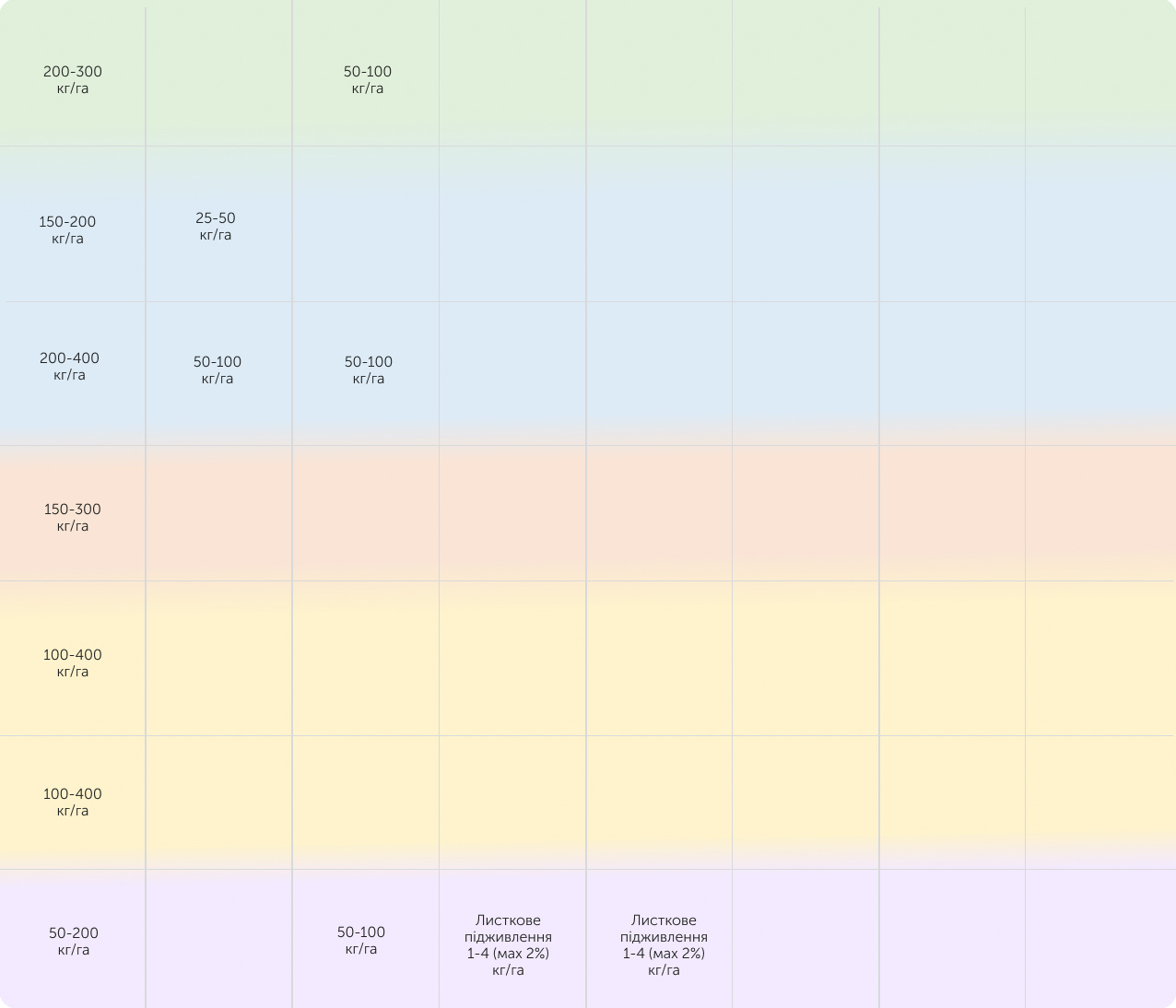








Principles of application
Sugar beet fertilization system has its own peculiarities. To get 1 t of root crops with the corresponding amount of sugar beet top, the crop consumes of 4,3 kg/ha of N, 1,3 kg/ha of P2O5 and 5,1 kg/ha of K2O. Only 2 kg of N, 0,7 kg of P2O5 and 2,2kg of K2O are to applied directly with the root crops. In the absence of organic fertilizers to achieve the yield of 600 quintals/ha it is necessary to apply N200-250P80-100K220-250. Ratio of the main nutrients (N:P2O5:K2O) in sugar beet fertilization system high-intensity hybrids is 1:0,3:1,4. High consumption of nitrogen and potassium requires their presence in the soil in available forms. Surplus of nitrogen and potassium reduces sugar outflow from beet and worsens its quality because of alpha-amino nitrogen which inhibits sugar separation from sugar syrup.
A significant majority of fertilizers are used for basal application. Full dose of phosphorous and potassium should be applied under tillage and to be mixed with soil. It is advisable to apply not more than 20% of total phosphorous during at sowing application and feeding. Feeding with potassium and phosphorous fertilizers is non-effective.
There are three stages of fertilizer elements consumption during sugar beet vegetation, at each stage potassium consumption prevails over other elements including nitrogen. Nutrients demand is insignificant prior to the stage of 3-4 pair of leaves. This period can continue from 40 to 45 days. Beginning with the stage of fifth pair of leaves it is a time of quick nutrients uptake including nitrogen and potassium during 80-90 days. The maximum uptake is observed in phase of intensive leaves growth and root crops formation. When the leaf growth mass halts and sugar is being accumulated, nutrients uptake slows down and they are partially moving from leaves to root crop.
Nitrogen fertilizers have the greatest impact on yield formation. They are to be used for feeding and at sowing application. Basal application of nitrate form of nitrogen is allowed only in spring. Application in autumn causes nitrogen losses due to outwashing during autumn-winter period. High concentration of nitrate-ions can have a toxic influence on underground seedlings. This form of nitrogen is the most effective in feeding. The rest of nitrogen forms are effective throughout vegetation taking into account application requirements. Liquid ammonia is better to apply after plowing during ground leveling to the depth of at least 12 cm depending on humidity and soil texture. Liquid ammonia water solution (aqua ammonia) can be applied while main tillage and feeding to the depth of at least 10 cm.
The first feeding is to be applied at the stage of 2-3 pair of leaves in rate N20-40 or full rate N20-40P20-30K30-40 to the depth of 8-10 cm at the same distance from the row. The feeding is applied at the stage of 4-5 pair of leaves in rate N20-40 to the depth of 10-12 cm in the mid row. Moisture providing influences nitrogen availability. Sugar beet responds best to the nitrate form of nitrogen, that is why this form is the main in fertilizing. At high temperatures, ammonium and amid forms of nitrogen turn into nitrate form for several days so that there is no nitrogen loss.
Nitrogen application should base on yield balance and total harvest of sugar.
Starting from germination of seeds, sugar beet becomes sensitive to phosphorous supply because root system development depends on its availability. Soil solution reaction has great influence on phosphorous availability. When phosphorous is the most available, optimal reaction is neutral. In the process of vegetation, phosphorous value increases and uptake goes smoothly. Insufficient supply of mobile phosphorous compounds in sugar beet at the beginning of vegetation can not be eliminated by phosphorous feeding at higher doses. Sugar beet has special requirements for potassium intake. Potassium stimulates the plants growth, distribution of nutrients in tissues, regulates photosynthetic activity, increases water-retaining capacity and hygroscopicity. Potassium deficiency slows plant growth rate, accelerates the decay of leaves that leads to its necrosis. The largest consequence of insufficient potassium supply is the interference with the normal transportation of sucrose to root crops.
Basal application of potassium fertilizers in autumn reduces salt load on the crop throughout the growing season. Chloride form of potassium fertilizers has an edge over sulphate form, because it contains small amount of nitrate which plays a similar to potassium role in physiological processes with less energy costs. The presence of sodium in fertilization program increases yield. Meantime it can be completely replaced by potassium without adversely affecting. Sugar beet requires chlorine in small amounts to maintain salt balance. Surplus potassium intake reduces sugar yield and worsens sugar quality.
The role of sulphur in beet nutrition is less pronounced in comparison with other crops, that is why the demand for it is insignificant. Optimal ratio between nitrogen and sulphur in sugar beet is 15:1.
For maximum sugar accumulation it is required well-developed leaf surface which stimulates photosynthetic activity that occurs under sufficient magnesium supply.
Leaf and root crop mass growth in July-Augustus is the period of maximum nutrients uptake by sugar beet.